Telescope sweep in stunning detail
 A high-tech telescope in the West Australian outback has produced incredible new pictures of our Universe.
A high-tech telescope in the West Australian outback has produced incredible new pictures of our Universe.
The GaLactic and Extragalactic All-sky MWA, or ‘GLEAM’ survey, has produced a catalogue of 300,000 galaxies observed by the Murchison Widefield Array (MWA), a $50 million radio telescope located at a remote site northeast of Geraldton.
It is the first radio survey to obtain images of the sky in such amazing technicolour.
“The human eye sees by comparing brightness in three different primary colours – red, green and blue,” said Dr Natasha Hurley-Walker, from Curtin University and the International Centre for Radio Astronomy Research (ICRAR).
“GLEAM does rather better than that, viewing the sky in 20 primary colours.”
GLEAM is a large-scale, high-resolution survey of the radio sky observed at frequencies from 70 to 230 MHz, observing radio waves that have been travelling through space - some for billions of years.
“Our team are using this survey to find out what happens when clusters of galaxies collide,” Dr Hurley-Walker said.
“We’re also able to see the remnants of explosions from the most ancient stars in our galaxy, and find the first and last gasps of supermassive black holes.”
MWA Director Associate Professor Randall Wayth, from Curtin University and ICRAR, said GLEAM is one of the biggest radio surveys of the sky ever assembled.
“The area surveyed is enormous,” he said.
“Large sky surveys like this are extremely valuable to scientists and they’re used across many areas of astrophysics, often in ways the original researchers could never have imagined,” Associate Professor Wayth said.
The GLEAM survey with the MWA is another step on the path to SKA-low; the low frequency part of the international Square Kilometre Array (SKA) radio telescope to be built in Australia in coming years.
The research paper on the survey is accessible here, and the team has created an interactive visualisation of their findings, available below.








 Print
Print